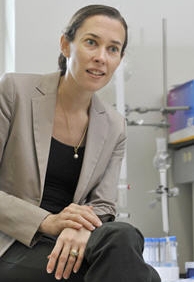18 August 2014. Biomedical engineers at Johns Hopkins University in Baltimore developed a synthetic lubrication fluid for natural or artificial joints in the body that emulates the properties of natural substances. A team led by Johns Hopkins medical professor Jennifer Elisseeff published its results earlier this month in the journal Nature Materials (paid subscription required).
Knees, hips, and elbow joints have a naturally-produced lubricant called hyaluronic acid found in the joints’ synovial fluid, a viscous substance that resembles motor oil. Hyaluronic acid also helps joints protect against inflammation and metabolic damage.
As people age or the joints become damaged, however, concentrations of hyaluronic acid become lower, leading to pain. The lower concentrations are believed to result from the lack of a key protein that binds hyaluronic acid to joint surfaces.
Some patients with osteoarthritis, the common wear and tear on joints as people age, try injections of hyaluronic acid to restore the joints’ natural lubrication, a treatment known as viscosupplementation. The technique, however, often requires several weeks to take effect and in a systematic review of clinical trials, showed little benefit for relieving pain or improving joint function. The review also showed viscosupplementation increases the risk for adverse effects.
One of the reasons for the limited benefit of viscosupplementation is the inability of joints to retain hyaluronic acid, which gets washed away by the body’s natural cleansing process. Elisseeff and colleagues sought to remedy this property by devising peptides, short chains of amino acid molecules, that are tethered to biocompatible polymers, but also bind with hyaluronic acid molecules.
The Johns Hopkins team tested these binding peptides with both natural and artificial cartilage samples in the lab, and later in the knees of lab rats. The tests used the binding peptides with polyethylene glycol, a common biocompatible polymer, to connect the hyaluronic acid with cartilage tissue in both the samples and animal tests.
The researchers found the engineered binding peptides/hyaluronic acid compound reduces friction as well as natural hyaluronic acid. When injected into the knees of lab rats, the tests show the engineered compound lasts 12 times as long as natural hyaluronic acid. The results suggest the compound could be a useful addition to viscosupplementation, as well as a coating for replacement joints.
“What I like about this concept,” says Elisseeff in a university statement, “is that we’re mimicking natural functions that are lost using synthetic materials.” Elisseeff and a colleague filed a patent application last year covering biomaterials combining binding peptides with biocompatible polymers for retaining hyaluronic acid and other tissue engineering applications.
Read more:
- Trial Testing Amniotic, Umbilical Grafts to Heal Wounds
- Novartis Licensing Smart Lens Technology from Google
- Paralyzed Man Moves Hand with Neuro-Signal Implant System
- Spin-Off Company Develops Drill-Less Tooth Cavity Treatment
- Students Invent Germ-Killing Catheter, Start Company
* * *


 RSS - Posts
RSS - Posts
You must be logged in to post a comment.